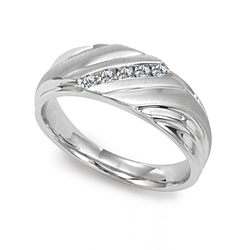Diamonds, sapphires, rubies…we know the gems and the mystique that surrounds them. But often we overlook the equally important metals in our jewelry. The metal is often behind-the-scenes, supporting and displaying its dazzling centerpiece – but each metal possesses a magic of its own.
This week, let’s focus on the many facets of gold:
GOLD
Gold is popular because it can be worked into almost any shape. Yellow gold jewelry of 18K and above does not tarnish and rarely causes problems for people with skin irritations. White Gold is popular for its appearance and price point compared to platinum alloys.
Technically there is no such thing as ‘White Gold.’ Gold can be lightened by combining it with light metals such as Rhodium; a member of the platinum family and the whitest precious metal after silver. This rhodium plating creates a hard skin with good resistance. Over time plating may wear through. Re-plating is a fairly simple process, depending on the condition of the piece. In most cases this will be done approximately as often as a platinum ring requires re-polishing, although a fine plating job may last longer than a polish on platinum due to the superior hardness of rhodium.
COMMON GOLD ALLOYS
24K gold (100% pure gold) does not work well for jewelry because it is too soft. A more durable option is 18K gold, which is 75% pure gold. It has the richness of 24K gold where some of the less pure alloys may not.
Identification
18K gold is the most recognized global standard and will be marked ’18K’ in the USA and ‘750’ in Europe.
1. 18K Yellow Gold
* 75% Gold, alloyed with Copper, Silver, Zinc and/or Cobalt
* Does not require plating
* Very workable
* Rarely causes skin irritation
* Will wear down, but over a long period of time with heavy wear2. 18K White Gold (nickel white gold)
* 75% Gold, alloyed with Copper, Nickel, Zinc and/or Palladium
* Requires rhodium plating and re-plating over time, depending on wear
* Less workable, less ductile
* Causes skin irritation for people with nickel allergies
* Will wear down over a long period of time3. 18K Palladium White Gold
* 75% Gold, 25% Palladium
* Requires rhodium plating and re-plating over time, depending on wear
* Very workable
* Rarely, if ever, causes skin irritation
* Will wear down over a long period of time
* More expensive than 18K nickel WGComparison Photos
1. 18K yellow gold
2. 18K white gold, rhodium plated
3. 18K palladium white gold, not platedSource: Pricescope Diamond Journal
Here’s our high-style, white gold gent’s engagement ring:
Style 7180WB
Gent’s 14kt White Gold Diamond Wedding Band
Gent’s 14kt white gold wedding band, diagonal design with .20ct t.w. channel set diamonds, high polished and matte finish, 7.75mm tapered.
Metal: 14kt White Gold
Width: 7.75mm
Stone Size: .20ct t.w.
Ring Size: 8.5 – 13


